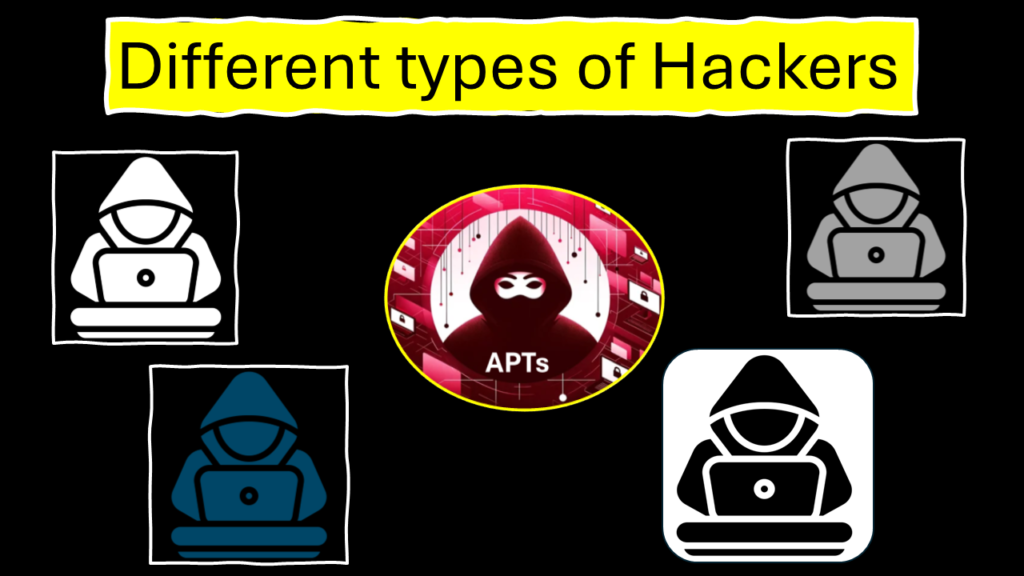In today’s digital world, when we hear the word ‘hacker,’ we might picture mysterious individuals causing chaos online. But the reality is much more complex. Hackers come in all shapes and sizes, each with their own story and purpose. Let’s take a closer look at this diverse community and explore the various types of hackers out there:

1. White Hats: The Guardians of the Digital Frontier
Think of white hats as the good guys of the hacking world. These ethical hackers use their advanced skills for a noble purpose: improving security. They’re often employed by companies, organizations, or governments to identify weaknesses in systems, networks, and applications before malicious actors exploit them.
Why do companies hire white hats? It’s like inviting a security expert to try and break into your house to find vulnerabilities. If they succeed, you know you need to fix your locks or alarm system. Similarly, white hats attempt to breach a company’s systems ethically and legally. This helps identify security gaps before real-world cybercriminals find them and potentially steal data or disrupt operations.
Here’s a closer look at some white hat subcategories:
- Penetration Testers act like attackers, simulating real-world tactics to uncover vulnerabilities in a system’s defenses.
- Bug Bounty Hunters are independent security researchers who scan software and systems for bugs or security flaws. If they find one, they report it responsibly to the company and often receive a reward.
- Certified Ethical Hackers (CEH) are professionals who have earned a specific credential demonstrating their skills and knowledge of ethical hacking methodologies.
What motivates white hats? It’s the thrill of the challenge, the satisfaction of securing the digital world, and the desire to stay one step ahead of cybercriminals.
2. Black Hats: The Nefarious Side of Hacking
Black hats are the polar opposites of white hats. They’re the malicious hackers we hear about most often in news stories about data breaches and cyberattacks. These individuals break into computer systems without permission, often with harmful intentions. Their motives can range from stealing sensitive data like credit card numbers or personal information to holding systems hostage with ransomware (demanding money to unlock them) or simply causing disruption and chaos.
Imagine this: A black hat hacker might break into a hospital computer system to steal patient records and sell them on the black market. These stolen records could then be used for identity theft or other criminal activities.
Black hat motivations are diverse:
- Financial gain: Stealing money, credit cards, or other valuables.
- Cybercrime: Launching large-scale attacks to disrupt critical infrastructure or steal data for further criminal activity.
- Hacktivism: Using hacking for political or social activism, sometimes defacing websites or leaking sensitive information.
- Malicious thrill: Some hackers simply enjoy the challenge and power of breaking into secure systems.
Black hats can operate as individuals or as part of organized cybercriminal groups, often employing sophisticated tools and techniques to evade detection.
3. Gray Hats: The Moral Maze
Gray hats occupy a murky area between white and black hats. They discover vulnerabilities in systems, but their actions can be unpredictable. Sometimes, they might responsibly report the flaws to the affected organizations. Other times, they exploit the vulnerabilities for personal gain (like accessing restricted data) or even accidentally cause damage.
Here’s an example: Imagine a hacker finds a weakness in a government agency’s network and exploits it to expose security flaws publicly. While their intention may be to raise awareness about the vulnerabilities, their actions could inadvertently disrupt critical operations or even put sensitive information at risk.
What drives gray hats? It’s a complex mix of curiosity, ego, and the desire to test their hacking skills. While they may not have inherently malicious intent, their actions can have serious consequences.
4. Blue Hats: The Freelance Guardians
Blue hats are similar to white hats, but they operate independently like freelance security consultants. They’re not formally employed by a company but still have permission to test a system’s security. Think of them like security researchers who work on a project-by-project basis.
Imagine this: A blue hat cybersecurity researcher discovers a vulnerability in a widely used software application. They responsibly report the flaw to the company and potentially receive a reward for their discovery.
What motivates blue hats? It’s a combination of financial rewards, recognition within the security community, and the satisfaction of contributing to a safer digital world.
5. Elite Hackers: The Rockstars of the Hacking World
They possess exceptional skills and knowledge, allowing them to find and exploit vulnerabilities before anyone else even knows they exist. Elite hackers are the apex predators of the hacking world, possessing unparalleled skills and knowledge. For example – Advance Persistent threats (APTs).
Here’s what distinguishes elite hackers:
- Expertise: They possess advanced skills and techniques, allowing them to uncover critical security flaws.
- Motivation: Their motivations vary, ranging from the intellectual challenge of hacking to malicious intent for personal gain.
- Example: An elite hacker discovers a critical flaw in a widely used operating system, potentially compromising millions of devices.
Conclusion
Each type of hacker operates within a distinct ethical and legal framework, with motivations and objectives that shape their activities. While some hackers strive to improve cybersecurity and protect against threats, others exploit vulnerabilities for personal gain or malicious intent.
Understanding these distinctions is crucial for organizations and individuals to navigate the complex landscape of cybersecurity. By recognizing the diverse motivations and behaviors of hackers, stakeholders can develop strategies to mitigate risks, enhance defenses, and foster a safer digital environment for all.
=====================================
Watch full video to understand more in details about these hackers.